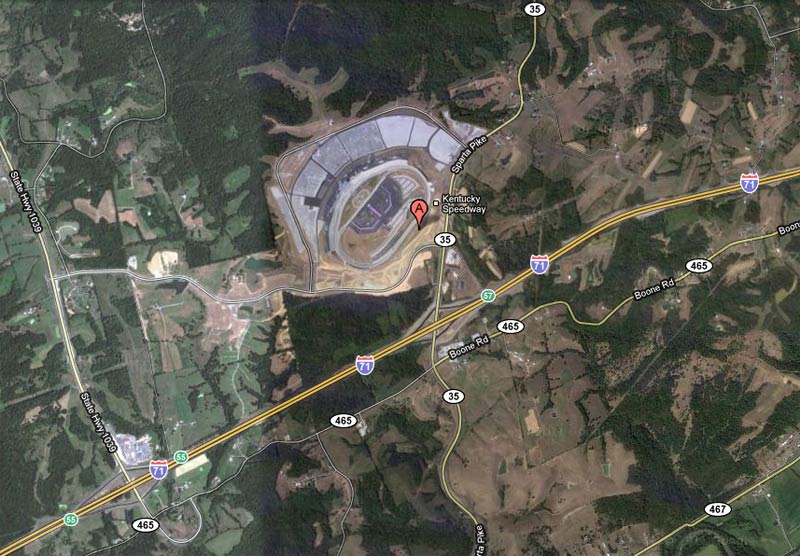
After a failed parking plan or transportation system, depending on which side you’re on, at the Kentucky Speedway’s big NASCAR race over the weekend, it’s easy to see how the problems plaguing the speedway are really the same as those in every auto-dominated, sprawling planning model. It shouldn’t be difficult to see why a model allowing access only by a single interstate and two roads couldn’t handle cramming 100,000 people travelling by car into a single parking lot. Instead, delays of up to 5 or 6 hours to travel mere miles causing some visitors to miss the race came as completely unexpected to state and racetrack officials.
In days following the race, racetrack officials complained that the roads and interstates couldn’t handle the traffic onslaught of private vehicles, and track chairman Bruton Smith called on the governor to invest taxpayer money in expanding Interstate 71 to handle traffic to his private venue. State officials at the Kentucky Transportation Cabinet defended the current highway capacity, instead blaming the speedway’s parking plan that couldn’t admit cars fast enough.
So how is it that twice a year on the same weekend Louisville’s Churchill Downs can handle crowds dramatically larger than what we saw last weekend without causing fans to miss the race? The answer is in transportation options.
Three easy examples. In the Downs’ urban setting, there’s a street grid that disperses traffic efficiently rather than piling it up on a single road like an interstate highway. Because it’s in an urban setting and not isolated, there are more options for parking, allowing those who choose to park farther away and walk. There are a variety of transit options to get to the track, some with priority over private cars.
There’s no quick fix to the problem of traffic at the speedway and I’m not about to propose one, but it does offer a clear example of why this limited type of transportation system isn’t efficient for handling large amounts of traffic in short spans. It’s quite similar to the traffic experienced each day in Louisville’s interstate rush hour, where drivers stuck with only one choice–the highway–must sit in traffic (and be the traffic) that the highway originally promised to reduce. It’s built into the system.
(I’m honestly not too invested in the debate about how to improve the situation at the speedway, but in an election year, there’s already some dangerous rhetoric out there. If you’re following it, the Herald-Leader probably has the best coverage.)



All very good points. And, as an Oldham County resident who works downtown and makes rather frequent trips to Cincinnati, it annoys the crap out of me every time I drive past the speedway and the only 6-lane section of I71 between Louisville and I75. With this state’s screwed up prioritiies, there is a far greater chance that section will get widened further than there is of widening any portion of I71 within the Gene Snyder.
Knowing the limitations of the roadways in and out of the site, I planned for lousy traffic. We planned to arrive earlier than we did, with something to do while parked and before going in to the track (if necessary–we wound up spending most of that time in the car waiting to get in, but that was the cushion built into our plan).
Knowing the limitations for egress, we planned (had food and water in the car) for waiting out some of the traffic before trying to drive away. It worked for us. We saw no reason to get stressed over the reality of heavy traffic–we simply dealt with it.
Yes, planning could have gone better–and should have. Yes, I would like to see them do a better job of planning for next time, if there is a next time. Your points about Churchill Downs being in a grid system and thus having far more egress points and ability to dissipate traffic are on the mark.
As someone who has some working knowledge of what happened at the Speedway, you are pretty much on target.
You can widen Interstate 71 to ten lanes wide, but it wouldn’t have solved the underlying issue. Traffic didn’t congest because the interstate was only four lanes for most of its length, it congested because of several factors.
The parking spaces began filling up around 1 PM, much, much earlier than expected. They anticipated more people would be cramming into fewer cars, but instead, fewer people were spreading out in more cars. They literally ran out of parking spaces, so traffic had no where to go. They began to back up onto the interstate, causing a 15-20 mile queue to US 421 to the south and Interstate 71/75 to the north – 20 miles.
And none of this was communicated to the drivers. There were few attendants. The state police were unhelpful and uncommunicative – I suppose they had no clue what to do or what was going on either.
There was also the infield problem, where drivers were literally sitting for over an hour just to exit through a ONE lane tunnel under the track.
Bad PR all around – for the Speedway, for the state and for NASCAR.
Hopefully drivers can channel their frustration into support for alternative transportation options. More buses, more car- and van-pooling and, dare I say, trains. All these options, even if a person doesn’t want to use them, should be supported because they would take cars off the road and therefore free up a space for you, NASCAR fan.
The only way I think we can change this problem is to make it hugely expensive to drive there, while making alternatives available and cheap. Let’s get more creative than “Widen the interstate! Add more parking!”